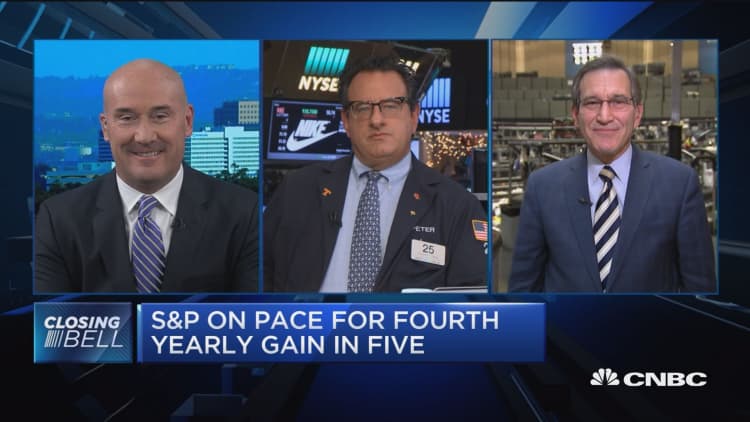
Despite a lackluster day in the stock market, the Dow finished 2016 up 13.42 percent, while the narrowly missed out on ending the year with double-digit gains.
The Nasdaq Composite, meanwhile, wrapped up 2016 with a net gain of 7.5 percent.
The Dow ended the day down 57.18 points at 19,762. It had been on pace to end the year 14 percent higher, but instead finished only 13.42 percent higher after its first down week since the election.
The S&P fell about 10 points, or about half a percent, on Friday, after ending Thursday down less than a point at 2,249. In order to gain 10 percent for the year, the index had to close at 2,248.33, but it finished at 2,238.83. The index now has four positive years in the past five.
The Nasdaq closed 48.97 points lower on Friday, down 0.9 percent. Still, it notched its fifth positive year in a row for the first time since its five-year streak that ended in 2007.
The best and worst of 2016
The best Dow performer year to date ended up being Caterpillar, which gained 36.46 percent. It was followed closely by UnitedHealth, which finished the year up 36.04 percent. Nike was, by far, the worst performer of the year, down 18.67 percent, its worst annual performance since 2008 when it fell 20.61 percent.
Of the S&P 500 companies, Nvidia is the year's top performer, up about 223.8 percent, followed by Oneok, which rose 132.8 percent and is the only other stock in the S&P to double in 2016.
On the other side of the spectrum, Endo International takes the title of the year's worst-performing stock in the S&P, down 73.1 percent, followed by First Solar, which fell 51.4 percent.
The biggest winners of the S&P were energy (up 23.65 percent), financials (up 20.14 percent) and telecom (up 17.81 percent). On the losing side of the S&P, health care was the only sector to finish negative, losing 4.36 percent.
Looking ahead to 2017
Tobias Levkovich, Citigroup's chief U.S. equity strategist, expects another solid move higher for stocks in 2017, with his target of 2,425 for the S&P 500. He said investors are more hopeful, but not yet overly euphoric.
He expects a better environment for stocks, with an improving economy and better business climate, based on the proposals of the incoming Trump administration.
"There's very little question that a reduced regulatory backdrop with reduced taxes should encourage corporate animal spirits. The two things businesses are most concerned by is high taxation and high regulation," he said.
Energy should no longer be the drag it had been, and that should be another positive for stocks. "[S&P] earnings should grow in the 6 to 7 percent range. Half of that is just energy not being a drag like it was last year," he said.
Oil recovered sharply from its February bottom, where prices traded in the $20s per barrel. U.S. benchmark West Texas intermediate (WTI) crude futures settled down 5 cents at $53.72 and gained 45 percent since January for its best year since 2009.
Treasury yields closed lower on Friday, but are up year over year. The 10-year yield closed at 2.446 percent, which was higher than its 2.275 percent close on Dec. 31, 2015. The closed at 1.198 percent.
"This year there's a double incentive not to sell. There's a potential that capital gains rates would be lower next year," said Randy Frederick, Charles Schwab managing director, trading and derivatives.
But Frederick and others said there have been pressures on the market this week, including the rebalancing of stock and bond positions by pension funds.
"You've got portfolio changes. You have professional investors trying to hit benchmarks," he said.
Bespoke Investment Group co-founder Paul Hickey shared his thoughts on 2017 with CNBC.
"In the short term, we may see some optimism next week and into the new year," he said. Short-term optimism, however, may not necessarily translate into gains later into 2017 once things slow down in Washington, he added.
Frederick said the market could see some tax-related selling next week by investors who expect lower capital gains tax rates in 2017. President-elect Donald Trump has said getting rid of the Affordable Care Act is a priority, and that means the additional 3.8 percent add-on to the capital gains tax for some investors would also go away. The capital gains tax rate is 20 percent.
Around the Jan. 20 inauguration may also be a time for selling, as Trump takes office and investors start to look for action on some of his promises, Frederick said. Trump's proposed tax cuts, reduced regulation and infrastructure spending have helped fuel a 5 percent gain in the S&P since the election.
"There's two times to be concerned in January. Economically the backdrop is solid, but you could argue, we'll have a little more volatility," Frederick said.
— CNBC's Chris Hayes and Gina Francolla contributed to this report.



